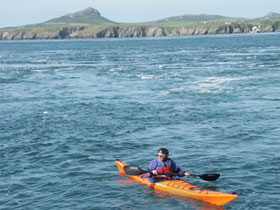
A great choice for wildlife trips in the Llyn Peninsula is offered by Shearwater Coastal Cruises. who run coastal wildlife cruises along the Lyyn Peninsula, visiting seal and seabird colonies. Check out their site for full details and prices.
They have written to me with the following interesting information on the sealife of the area:
“On most of our cruises, we can expect to be joined by the resident bottlenose dolphins. The catamaran hull format of “Shearwater” seems to be particularly attractive to the dolphins that obviously enjoy riding the considerable double bow-wave that is produced. Our cruises take us to both of the two main Grey Seal colonies off the Llyn Peninsula. A group of approximately 150 seals inhabit the islands of St. Tudwals, off Abersoch and a much larger colony is to be found around the shores of Bardsey Island. Small satellite groups occasionally detach themselves from these main populations and may be found in places such as the Gwylan Islands and Cilan Headland with a more notable, semi-permanent group residing on the northern coast of the Llyn Peninsula, near Porth Dinllaen/Nefyn golf course.
The rocky coast and offshore islands of the Llyn Peninsula offer important nesting sites for seabirds. Notables such as Manx Shearwaters, Puffins, Razorbills, Guillemots, Black Guillemots, Shags, Cormorants, Kittiwakes, along with other Gull species are commonly seen. Terrestrial predators such as Ravens, Buzzards and Peregrine Falcons, inhabit the sea cliffs and rocky islands as do the Chough which is a common resident along these shores and, happily, is firmly established and doing well.
This northern part of Cardigan Bay is also blessed with some very unusual and spectacular marine wildlife. Few people realise that these waters provide a home for the Leatherback Turtle, the only warm blooded reptile in existence. These huge creatures, often weighing 1 metric ton and approaching 3 meters in length spend most of their adult life here, feeding on the vast shoals of Barrel Jellyfish (Rhysostoma).
The Harbour Porpoise, that seems to be under threat elsewhere can be seen readily, feeding off the headlands of the Peninsula, particularly within the area of Bardsey Sound. Here also one can sometimes see the enigmatic Rissos Dolphin, that otherwise plies up and down the Irish Sea in pursuit of squid and other prey. These creatures have a blunt nose, are light grey in colour and bear numerous large scratch marks, inflicted during play/mating activity.
Easily the most spectacular creatures we encounter on our wildlife cruises are the Bottlenose Dolphins. The groups we see are part of the Cardigan Bay population that exceeds 360 individuals (although we are finding more each season). Whilst running our wildlife cruises, we have for the last few years undertaken dolphin Photo-ID and monitoring tasks on behalf of the “Seawatch Foundation”, a charitable body responsible for monitoring cetaceans around the coast of the UK.
Our work with “Seawatch” has given us a considerable insight into the behavioural characteristics of the dolphins. We can also, now, readily recognise individuals (from marks, scratches and pieces missing from dorsal fins). “Seawatch” also kindly send us feedback from our inputs and it is interesting to examine the travel itineraries of some of the individual dolphins we see. We have for instance, taken a photograph of a dolphin on a particular afternoon and the same animal has been recorded off New Quay, almost 50 miles away the very next day. We often see the same groups day after day, but occasionally we will encounter a huge pod, numbering up to 50 individuals that have simply come up to our area from the south of Cardigan Bay on what seems a fleeting ’round-the-bay’ tour, describing a large arc and heading back south again.
Having been running the “Shearwater Coastal Cruises” for the last 9 years we do get a feeling for the absence, decline or abundance of wildlife species from season to season.Anecdotally, of course, we notice that the auks, Herring Gull and Kittiwake numbers vary the most from one year to the next. We seem to have a gradual increase in the Chough population and Herons, with their heronry in Pwllheli town, seem to have increased markedly. Over recent years we have noticed the presence of the odd Red Kite, presumably due to the expansion of the mid-Wales population and Peregrine Falcons seem to have increased.
The Grey Seal population seems to have steadily increased over this period and we see more dolphins now that we did before, but this may be due to our becoming more familiar with the location of their favourite feeding areas and developing a more practiced eye. We have not noticed any decline in the number of porpoises we see, but we have realized for some time that they will always keep well away from any areas where there are dolphins. The area does attract a lot of recreational boat traffic at peak holiday times and we notice that dolphins can be reluctant to visit or remain in their favourite feeding areas at these times. The opportunity is not lost on porpoises that soon take their place once the dolphins are absent.
In summary, the wildlife we see daily seems to be thriving and numbers seem to be at least similar to those we saw when we began 9 years ago, with a number of species increasing markedly. Furthermore, the Llyn Coastal area is apparently being blessed with the increasing presence of the otter – as if we needed any further encouragement to put to sea every day!






